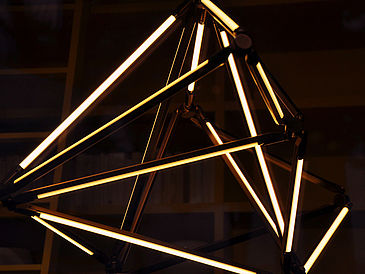Reactions with noble gases have long been a cause of fascination for chemists. The substances used as light sources in fluorescent tubes, for instance, are extremely slow to react in respect of their chemical reactions – they are therefore called “noble”. A newly published study in this area of basic research is currently causing quite a stir in expert circles. An international team of researchers spearheaded by the University of Bremen has succeeded in bringing about a compound between noble gases and a negatively charged chemical substance. Negative substances exhibit an excess of electrons and are therefore supposed not to react with noble gases. With the help of experimental and computer-aided methods, the researchers from the universities of Bremen and Leipzig, the Bergisch University of Wuppertal and the US-American Pacific Northwest National Laboratory (PNNL) in Richland have uncovered the causes of this rather remarkable reaction behavior of anions and developed a completely new reaction concept. Expert evaluators see the study as a scientific breakthrough: So much so, that they are featuring it on the cover page of the current German and international printed issue of the world-renowned journal “Applied Chemistry” (No. 27), that appears on June 26, 2017.
Noble gases no longer quite so noble?
The research results initially run counter to textbook doctrine. This states that a noble gas can at best be compounded by a chemical substance exhibiting an electron deficiency which subsequently extracts electrons from the noble gas – despite its chemical inertness. The experimental results, however, leave no room for doubt: A negatively charged boron cluster – that is a compound with an excess of electrons containing the metalloid boron – actually did succeed in bringing about a compound between the noble gases krypton and xenon. Markus Rohdenburg, the study’s lead author, says “In order to solve this chemical puzzle that runs completely contradictory to accepted theory we had to carry out comprehensive theoretical investigations with state-of-the-art computer-aided methods”. Rohdenburg is currently putting the finishing touches to his doctoral thesis at the University of Bremen. He was already working on the project as a student. The authors’ understanding of noble gases, though, remains uncritical. “The reaction is solely due to the specific chemical nature of the negative boron cluster”, explains Professor Simon Grabowsky (Uni Bremen), who supervised the study together with his former Bremen colleague Dr. Jonas Warneke from the US-American Pacific Northwest National Laboratory in Richland. Although physically the boron cluster represents a negative particle, chemically it is effectively a positive one.This unusual combination of physical and chemical properties is the sole reason for the noble gases compounding under the given experimental conditions. The newly gained insights may lead to the development of practical applications; for example, in the isolation and storage of noble gases.
Successful study based on good cooperation
The study’s successful completion depended on the mutual pooling of expertise contributed by the research academics located in Bremen, Leipzig, Wuppertal, and Richland: While the researchers at the University of Bremen and the US-American Pacific Northwest National Laboratory thought up the underlying idea and carried out initial data readings and theoretical experiments, the other members of the team from the University of Leipzig conducted experiments on compounding noble gases and spectroscopic examinations. Expertise in boron cluster chemistry was brought in by the Bergisch University of Wuppertal, where the chemical synthesis of the boron cluster used for the study also took place.
The team of authors
The team of authors at the University of Bremen comprised Markus Rohdenburg, Professor Simon Grabowsky, Dr. Tobias Borrmann, Dr. Vladimir Azov and Florian Klemiss. Dr. Jonas Warneke was awarded his doctorate at the University of Bremen and is currently researching at the US-American Pacific Northwest National Laboratory (PNNL) in Washington. Contributing researchers at the University of Leipzig were Martin Mayer, Max Grellmann and Professor Knut R. Asmis, and at the Bergisch University of Wuppertal, Professor Carsten Jenne.
For further questions please contact:
University of Bremen
Faculty 2 – Biology / Chemistry
Institute for Applied and Physical Chemistry
Markus Rohdenburg
Phone: +49 421 218-63203
E-Mail: m.rohdenburgprotect me ?!uni-bremenprotect me ?!.de

